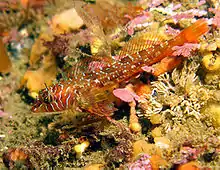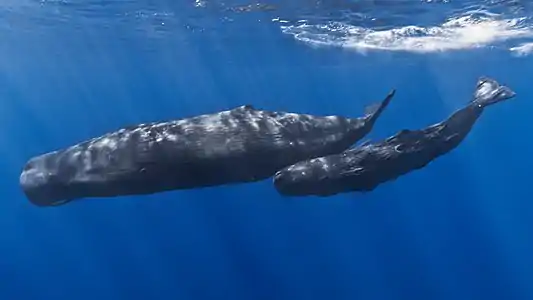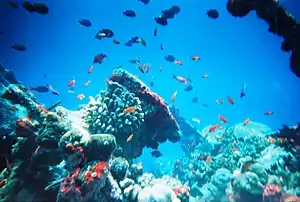Aquatic animal
An aquatic animal is an animal, either vertebrate or invertebrate, which lives in the water for most or all of its lifetime.[1] Many insects such as mosquitoes, mayflies, dragonflies and caddisflies have aquatic larvae, with winged adults. Aquatic animals may breathe air or extract oxygen that dissolved in water through specialised organs called gills, or directly through the skin. Natural environments and the animals that live in them can be categorized as aquatic (water) or terrestrial (land). This designation is polyphyletic.


Description
The term aquatic can be applied to animals that live in either fresh water or salt water. However, the adjective marine is most commonly used for animals that live in saltwater, i.e. in oceans, seas, etc.
Aquatic animals (especially freshwater animals) are often of special concern to conservationists because of the fragility of their environments. Aquatic animals are subject to pressure from overfishing, destructive fishing, marine pollution and climate change. Many habitats are at risk which puts aquatic animals at risk as well.[2] Aquatic animals play an important role in the world. The biodiversity of aquatic animals provide food, energy, and even jobs.[3]
Air-breathing aquatic animal
In addition to water breathing animals, e.g., fish, most mollusks etc., the term "aquatic animal" can be applied to air-breathing aquatic or sea mammals such as those in the orders Cetacea (whales) and Sirenia (sea cows), which cannot survive on land, as well as the pinnipeds (true seals, eared seals, and the walrus). The term "aquatic mammal" is also applied to four-footed mammals like the river otter (Lontra canadensis) and beavers (family Castoridae), although these are technically amphibious or semiaquatic. There are up to one million types of aquatic animals and aquatic species.[4]
Amphibians, like frogs (the order Anura), while requiring water, are separated into their own environmental classification. The majority of amphibians (class Amphibia) have an aquatic larval stage, like a tadpole, but then live as terrestrial adults, and may return to the water to mate.
Certain fish also evolved to breathe air to survive oxygen-deprived water, such as Arapaima (family Osteoglossidae) and walking catfish.
Most mollusks have gills, while some fresh water ones have a lung instead (e.g. Planorbidae) and some amphibious ones have both (e.g. Ampullariidae). Many species of aquatic animals lack a backbone or are invertebrates.[5]
Importance on environment
Aquatic animals play an important role on the environment as well as human's daily usage. The importance of aquatic animals comes from the fact that they are organisms that provide us with sources such us medicine, food, energy shelter, and raw materials that are used on a humans's daily life.
Each aquatic species plays a different role to help us make every day easier, healthier, and also more productive. They also help with the atmospheric pressure and global climate change. [6]
See also
References
- Biology Online Dictionary: "Aquatic" Archived 31 May 2009 at the Wayback Machine
- "Protecting Marine Wildlife". The Humane Society of the United States. Retrieved 7 October 2020.
- "World Organisation for Animal Health (OIE)". dx.doi.org. 2 November 2016. Retrieved 28 October 2020.
- "Ocean Habitat". Kids. 31 October 2016. Retrieved 28 October 2020.
- "Ocean Habitat". Kids. 31 October 2016. Retrieved 28 October 2020.
- What Is Aquatic Biodiversity; Why Is It Important?. Virginia, USA. 2019. p. 2.

